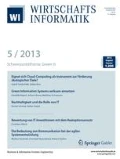Zusammenfassung
Die Beziehung der Wirtschaftsinformatik zu ihren Referenzdisziplinen Wirtschaftswissenschaften und Informatik war in der Vergangenheit einem stetigen Wandel unterworfen. Trotz einiger Spannungen in den 1980er- und 1990er-Jahren hat sich das Verhältnis zwischen Informatik und Wirtschaftsinformatik deutlich entspannt und als außerordentlich fruchtbar erwiesen. Wichtige Beispiele dieser Ko-Evolution sind konzeptuelle Modellierung und Datenmanagement, Internet-basierte Informations- und Transaktionssysteme und die Entwicklung von Computational Business Sciences. Die zunehmende Integration von virtueller und realer Welt bspw. durch Sensoren und Aktuatoren im „Internet der Dinge“ stellt neue fachliche und organisatorische Herausforderungen an die Zusammenarbeit zwischen Informatik und Wirtschaftsinformatik, die nur gemeinsam formuliert und gelöst werden können.
Abstract
The relationship between business and information systems engineering (BISE) and its main reference disciplines business administration and informatics has changed several times during the last decades. Despite some frictions during the 1980 s and 1990 s, the interplay between informatics and BISE is becoming much more constructive and has proven extremely fruitful. Important examples of this co-evolution include data management and conceptual modeling, internet-based information and transaction systems, and the emergence of computational business sciences. The increasing integration of virtual and real world in the “Internet of Things” offers new scientific and organizational challenges for the cooperation between the BISE and informatics, which can only be formulated and solved jointly.
Literatur
Biundo S, Claus V, Mayr HC (2006) Was ist Informatik? Gesellschaft für Informatik e. V.
Brooks FP (1987) No Silver Bullet: Essence and accidents of software engineering. IEEE Computer 20(4):10–19
Bullinger HJ, ten Hompel M (2007) Internet der Dinge. Springer, Heidelberg
Chen P (1976) The entity-relationship model: toward a unified model of data. ACM Transactions on Database Systems 1(1):9–36
Codd EF (1970) A relational model of data for large shared data banks. Comm. ACM 13(6):377–387
Dhar V (1998) Data mining in finance: using counterfactuals to generate knowledge from organizational information systems. Information Systems 23(7):423–437
Floerkemeier C, Langheinrich M, Fleisch E, Mattern F, Sarma SE (Hrsg) (2008) The internet of things. Proc. first intl conf IOT 2008, Zürich. LNCS 4952, Springer, Heidelberg
Friedman TL (2005) The world is flat. Penguin, London
Gray J, Liu DT, Nieot-Satisteban MA, Szalay AS, DeWitt DJ, Heber G (2005) Scientific data management in the coming decade. ACM SIGMOD Record 34(4):34–41
Hevner AR, March ST, Park J, Ram S (2004) Design science in information systems research. MIS Quarterly 28(1):75–105
Jarke M (2008) Holistic engineering of ultra-highspeed mobile information and communication systems. In: Kaschek R, Kop C, Steinberger C, Fliedl G (Hrsg): Information systems and ebusiness technologies, proc 2nd intl conf UNISCON 2008, Klagenfurt. LNBIP 5, Springer, Heidelberg, S 148–157
Kambil A, Weill P, Jarke M, Filos E, Loebbecke C, Feeny D (2003) Different IS research communities: are they competitors, complements, or ignoring each other. Comm AIS 11:513–524
Krcmar H (2004) Informationsmanagement, 4. Aufl. Springer, Heidelberg (englische Ausgabe im Druck)
Mylopoulos J, Borgida A, Jarke M, Koubarakis M (1990) Telos – representing knowledge about information systems. ACM trans information systems 8(4):325–362
National Science Foundation (o. J.) Science of design – software-intensive systems. http://www.nsf.gov/pubs/2004/nsf04552/nsf04552.htm
Scheer AW (1984) EDV-orientierte Betriebswirtschaftslehre. Springer, Heidelberg
Scheer AW (2002) Business process engineering. reference models for industrial enterprises, 2. Aufl. Springer, Heidelberg
Simon HA (1996) The sciences of the artificial, 3. Aufl. MIT Press, Cambridge
v. d. Aalst WMP, Kumar A (2003) XML-based schema definition for support of inter-organizational workflow. Information Systems Research 14(1)
Weiser M (1993) Some computer science issues in ubiquitous computing. Comm. ACM 36(7):74–84
Danksagung
Die vorliegende Arbeit wurde im Rahmen des DFG-geförderten Exzellenzclusters „Ultra-Highspeed Mobile Information and Communication (UMIC)“ an der RWTH Aachen gefördert.
Author information
Authors and Affiliations
Corresponding author
Additional information
This article is also available in English via http://www.springerlink.com and http://www.bise-journal.org: Jarke M (2008) Perspectives in the Interplay of Business and Information Systems Engineering and Computer Science. Bus Inf Syst Eng. doi: http://dx.doi.org/10.1007/s12599-008-0021-4.
Annahme nach einer Überarbeitung durch Prof. Dr. Buhl.
Rights and permissions
About this article
Cite this article
Jarke, M. Perspektiven der Wirtschaftsinformatik aus Sicht der Informatik. Wirtsch. Inform. 51, 82–87 (2009). https://doi.org/10.1007/s11576-008-0127-9
Received:
Accepted:
Published:
Issue Date:
DOI: https://doi.org/10.1007/s11576-008-0127-9

